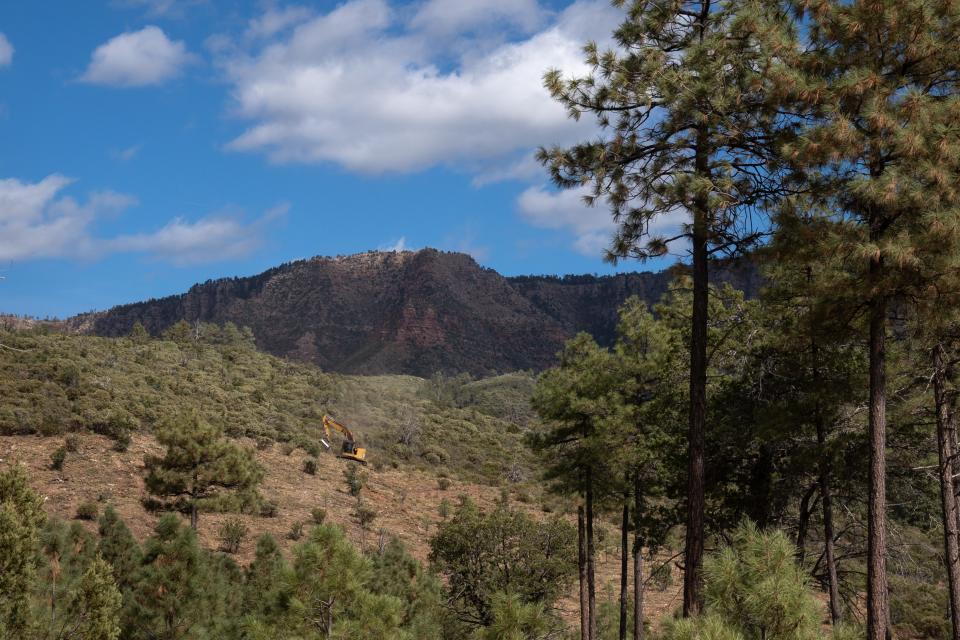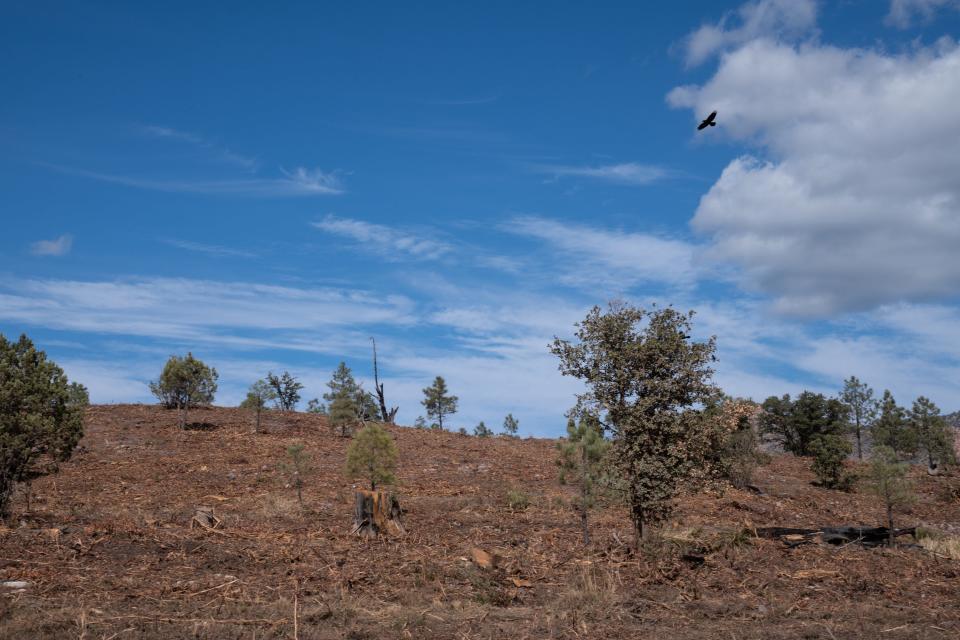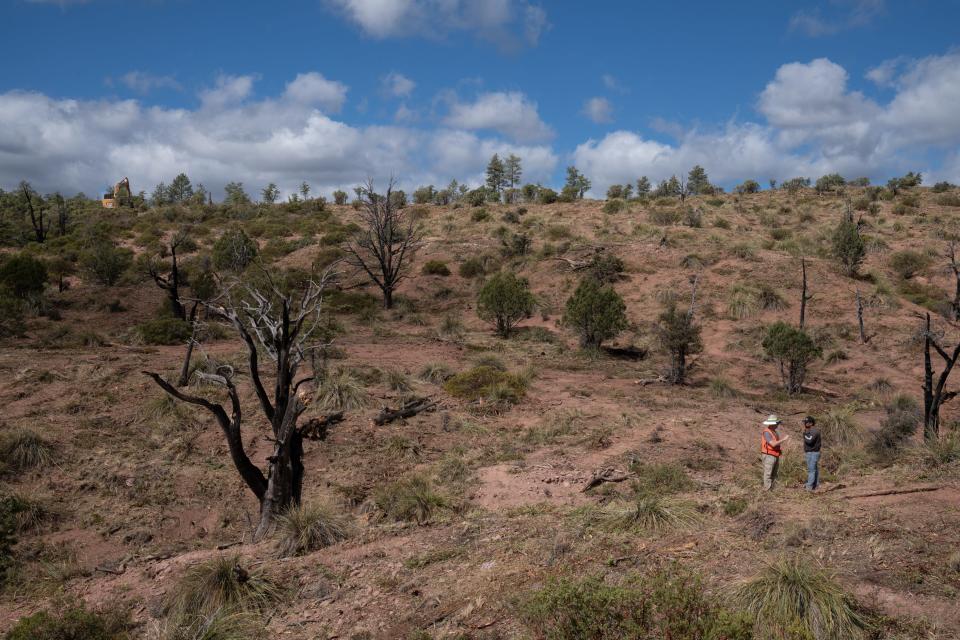30 years after the deadly Dude Fire, work begins in the forest to prevent another disaster
PAYSON — On June 27, 1990, two stories dominated the headlines in Arizona. One documented the hottest day on record in Phoenix, where the temperature peaked at 122 degrees. The second story reported that six firemen had been killed in the Dude Fire.
Now, 33 years later, forest managers are concerned history may repeat itself. Arizona experienced one of its hottest and driest summers, increasing wildfire danger across the state, and the Dude Fire burn scar has become an extremely high risk for another destructive fire.
An overabundance of fuels was one of the reasons why the Dude Fire was so destructive, and after decades of excessive fire suppression in forests, low-lying vegetation has taken over again.
To prevent future catastrophic fires, the U.S. Forest Service, Salt River Project and the Arizona Department of Forestry and Fire Management are thinning forest areas in northern and central Arizona. These thinning projects also promote healthy forests and protect the watershed.
Work has begun on a restoration project in the Dude burn scar, part of the Four Forest Restoration Initiative, a long-term project to assess 2.4 million acres of the Kaibab, Coconino, Apache-Sitgreaves and Tonto national forests to improve forest health. The initial goal was to restore 50,000 acres per year over 10 years.
The Dude burn scar poses a particular risk, and officials have prioritized it for treatment.
“The area has become so dense that you can’t walk through it. It is a wall-to-wall mass of bushes and shrubs,” said Elvy Barton, SRP’s water and forest sustainability manager. “When a fire hits that, it’s just going to carry straight through.”
Dense forests, dry conditions fuel the deadly Dude Fire
A dry lightning strike ignited the Dude Fire on June 25, 1990, in a forested area near Dude Creek, below the Mogollon Rim about 10 miles northeast of Payson. Although there have been more destructive fires since then, the Dude Fire stands out in Arizona wildfire history.
The blaze started on a southwest-facing slope at around 6,400 feet elevation. Due to 100-degree temperatures, years of below-average precipitation, steep slopes, strong winds and a buildup of fuels, the fire quickly spiraled out of control.
Flames grew into a crown fire, burning through the tops of the ponderosa pines. Fires that spread to the tree canopy are often the most intense, dangerous and difficult to contain. They move quickly and can cause widespread damage to forests, infrastructure and communities.
Driven by rapidly changing weather conditions, the fire behaved erratically, making it difficult to predict its path.
“When the weather changes like that, then you get very abrupt changes in fire behavior, and this has been seen repeatedly in fires that have caused fatalities,” said Don Falk, a professor at the University of Arizona School of Natural Resources and the Environment.

After being trapped by a giant wall of fire, six firefighters from the Perryville Prison crew died. At the time, the Dude Fire was one of the most deadly wildfires in Arizona. It destroyed 60 homes, endangering communities in Bonita Creek Estates and Pyle Ranch.
Firefighters eventually contained the fire on July 1, and in all, it burned 25,000 acres of forest.
Wildfire aftermath: Rodeo-Chediski Fire scarred Arizona forests. How have they changed in the past 20 years?
What does the Dude burn scar look like today?
At the Dude burn scar now, there’s a stark divide in the land, an obvious border line.
On one side, masses of low-lying shrubs and grasses, junipers, ponderosa pines and oak trees compete for resources. The husks of burnt trees stand tall among a sea of green overgrowth.
On the other side, the underbrush has been cleared around the stunted trees. The largest and healthiest oaks, junipers and ponderosa pines remain, and many of the snags linger too, a lasting reminder of the fire that ravaged the forest.
While the overgrown side may seem like a healthier forest, the sparse areas are the desired outcome of the restoration projects after treatment. Crews have started thinning sections of the burn scar, prioritizing ponderosa pines to “give them a fighting chance,” according to Barton.
The Dude restoration project is divided into four phases that will thin 2,600 acres of the East Verde watershed. The first phase, which covers 1,450 acres, will be completed over the next two months.
The area was once a ponderosa pine forest, but since the fire, the land has struggled to recover. In the three decades since Dude, the pines that have grown back are stunted, thin and a few feet tall, trees that appear to be only a couple of years old.
“Since 1990, the ponderosa pine forest is not coming back," Barton said. "All of the woody vegetation, the oaks, the junipers, are outcompeting the pines."

Oaks, aspens, shrubs and other sprouting hardwood species get a head start following wildfires. Their roots grow below ground, so if a fire occurs, they can immediately sprout and grow back.
Ponderosa pines take longer to sprout and fight for limited resources in higher temperatures. The overcrowding blocks sunlight and lower precipitation. The thinning treatments aim to restore conditions for trees like the ponderosa pines and remove dangerous fuels.
“We’re never going to get back what we once had, especially with the effects of climate change with increased temperatures and prolonged droughts,” Barton said. “But we can still make great strides and help the ponderosa pine recover in the area.”
Forest health: How thinning dense Arizona forests could prevent another megafire and protect water sources
Fewer fuels mean fewer large fires
Low-intensity, lightning-strike fires are an integral phenomenon in forest ecosystems. These fires remove fuels, keeping forests from overgrowing and preventing high-intensity fires.
Over the last 100 years, settlers have suppressed fires to protect communities and infrastructure, including the low-intensity fires that would prevent larger burns.
“By keeping fire out of the system, the fuels accumulate, and eventually when a fire happens, you get a Dude fire,” Falk said.

According to a study from Northern Arizona University's Ecological Restoration Institute (ERI), low-intensity fires in oak-pine forests on the Mogollon Rim occurred about every one to 16 years between 1700 and 1879. In the decades since, fires have not occurred as often because of fire suppression practices.
Frequent low-intensity fires would contain vegetation, keeping forest densities low and subduing oak, aspen and shrub species. Researchers have found that once human activity quenched fires, these species could establish and grow.
“Historically, fires were frequent along the Mogollon Rim and probably the most frequent in Arizona,” said Andrew Joel Sánchez Meador, the executive director of ERI and a professor at NAU's School of Forestry.
“Therefore, these areas are probably in the most abundant need of restoration, both from a watershed standpoint and because they have higher degrees of vulnerability that we’re seeing," Sánchez said.
Not only are the forests at risk of future destructive wildfires without treatment, but the Verde River watershed is imperiled too.
The vegetation on the watershed requires water to survive, and the plethora of greenery reduces water supplies to the Verde River ecosystem. Water quality, infrastructure and storage capacity are also threatened after a fire when rainfall washes ash and debris into rivers and reservoirs.
The Dude Fire was a warning signal for SRP and forest managers, according to Barton. The watershed supplying water to millions of people is jeopardized by repeated destructive fires.
Clearing excess fuels and maintaining natural, low-intensity fires will be vital to protecting forests and the watershed.
What to know: How forest managers use prescribed burns to prevent future wildfires
The Dude treatment plan starts with thinning
Crews use a mechanical thinning technique called mastication to treat the project area. Machinery cuts trees and brush into small pieces, creating a mulch-like material, which is then spread along the ground.
Mastication removes competing vegetation, allowing the remaining trees more water, sunlight and nutrients. Crews leave the largest juniper, oak and ponderosa trees with the best chance of survival.
“When individual trees are healthier, the forest in general is healthier,” said Patty Ringle, a forest silviculturist for Tonto National Forest.
After mastication treatments, the materials will need a few years to dry out and for vegetation to grow back.
While forest managers hope to prevent destructive wildfires, they will eventually ignite prescribed burns. Prescribed burns are beneficial to the landscape, removing excess fuels that grow back after treatment, bringing nutrients to the soil and strengthening the ecosystem overall.
Officials expect the project area will likely require repeated mastication treatments and prescribed burns, as many species grow back quickly and threaten to return the landscape to its previous state.
Ponderosa pine forests were historically more open than the forests are today, with less vegetation. Thinning treatments return these areas to their natural ecosystem and create space for foresters to plant additional pine seedlings.
The Forest Service will plant seedlings on about 3,000 acres once all treatment is completed.
Officials hope that with thinning and prescribed burns, the forests will reach a point where they can reintroduce low-intensity fire to the landscape over the years to maintain the forests and protect communities from wildfires like Dude.
Contributions from the agencies, Google, Pepsi and other non-profit and commercial partners have funded the restoration, which is expected to finish in 2026.
“While we’re getting stuff done every year, we have a monumental problem ahead of us. It’s going to take a village of partners coming together,” Barton said.
Hayleigh Evans covers environmental issues for The Arizona Republic and azcentral. Send tips or questions to hayleigh.evans@arizonarepublic.com.
Environmental coverage on azcentral.com and in The Arizona Republic is supported by a grant from the Nina Mason Pulliam Charitable Trust. Sign up for AZ Climate, our weekly environment newsletter, and follow The Republic environmental reporting team at environment.azcentral.com and @azcenvironment on Facebook, X and Instagram.
You can support environmental journalism in Arizona by subscribing to azcentral today.
This article originally appeared on Arizona Republic: Crews start to thin forests on the scar of the deadly Dude Fire

